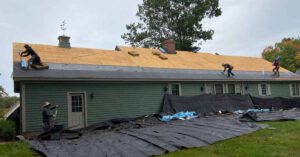A roof is a key component of your home’s structural integrity and beauty. It helps to insulate your house from cold and excessive heat while protecting it from rain and snow.
Roofing materials come in a wide range of styles and options. Choosing the right one for your home like can make it last longer and boost its resale value.
Roofing materials are an essential part of any building, as they protect the structure from rain, snow, wind, and other weather. They also provide a surface to collect rainwater, which is essential for gardens and buildings.
There are a number of different roofing materials to choose from, each with their own advantages and disadvantages. Choosing the right material for your roof is one of the most important decisions you can make when designing or building a house.
The type of roofing material used is largely influenced by the shape and size of your roof, the location and climate where it is located, and whether you intend to use it for residential or commercial purposes. The type of material will also have a significant effect on the cost and lifespan of your roof.
Common roofing materials include asphalt shingles, timber shingles, concrete tiles, and slate. These are mainly used for flat and low-sloped roofs, though some are suitable for pitched roofs as well.
Shingles are a popular roofing material and come in a wide variety of styles, colors, and designs. They are made from a base mat of wood fiber, cellulose, or other organic material that is saturated with asphalt to create a waterproof membrane.
They are then coated with a top coating of adhesive asphalt and ceramic granules that help them resist wear and environmental damage. They are inexpensive and durable, making them a popular choice for roofs in residential buildings.
Tiles are another widely used roofing material and have a long lifespan, up to 50 years. However, they are porous, so they are not as strong as clay or slate and need to be sealed regularly in order to keep them in good condition.
These are popular roofing materials for flat roofs and outbuildings, as they offer a fast and convenient way to cover the roof. They are a cheaper option than shakes and are available in a range of colors, styles, and designs.
A flat roof can be made of a range of different materials, from corrugated iron to Colorbond steel and load-bearing panels such as SIPs (structural insulated panels). The material used depends on the design of the roof, the location and climate where it is installed, and the needs of any equipment that is installed on the roof.
Roofing is a big job that requires a lot of manpower. It can take days, or even weeks, to complete a single roof. A quality contractor will have the tools, equipment, and supplies to get the job done.
The first thing that they will do is take a look at the old roof to determine what needs to be removed. If you have a shingle roof, they will use a shingle fork to pry up the older shingles, which they will put in a nearby garbage can.
They will also take a look at the structure under your roof, including rafters, trusses, and sheathing. They will make notes of any significant changes.
A good roofer will also tell you what type of material will be best suited to your home and will provide a detailed estimate for the cost of materials and labor. This is an important step, as a poorly installed roof will not only lead to major repairs but may also depreciate in value.
Next, they will lay down the underlayment. This is a synthetic and waterproof barrier that prevents melting snow from running under the shingles.
After they are satisfied that the underlayment is doing its job, they will then install the ridge rake (or a similar device for shingle-style roofs). It is a simple metal piece that goes over the top of the ice and water barrier, covering the eaves and allowing the ridge to stand out.

